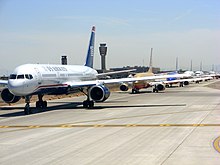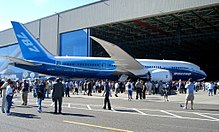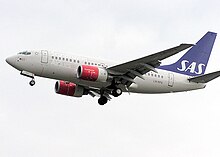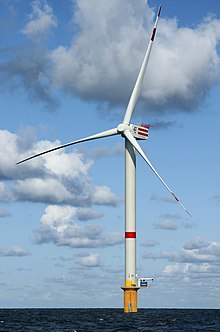Emissions
from aviation are continuing to grow despite advances in aircraft
efficiency. Currently 2% of global emissions are created by the aviation
industry.
Aviation affects the environment due to aircraft engines emitting noise, particulates, and gases which contribute to climate change and global dimming. Despite emission reductions from automobiles and more fuel-efficient (and therefore less polluting) turbofan and turboprop engines, the rapid growth of air travel in recent years contributes to an increase in total pollution attributable to aviation. In the EU, greenhouse gas emissions from aviation increased by 87% between 1990 and 2006.
At present aviation accounts for 2.5% of global CO2 emissions.
Due to projected growth in air travel, in the most technologically
radical scenarios for having a better than 50% chance of keeping global
warming below 2 degrees Celsius, in 2050 aviation will make up 15% of
global CO2 emissions. In more conventional scenarios its emissions will exceed the entire global carbon budget before then. This presents governments and the operators of aircraft with a responsibility to reduce the aviation industry's emissions.
General aviation reduction methods
Some
methods aim to mitigate aviation's environmental impact by reducing
aviation in general. This can be achieved through various means, such as
route optimization, emission caps, short-distance restrictions,
increasing taxation and decreasing subsidies.
Route optimization
Currently,
air traffic corridors that aircraft are forced to follow place
unnecessary detours on an aircraft's route forcing higher fuel burn and
an increase in emissions. An improved Air Traffic Management System with more direct routes and optimized cruising altitudes would allow airlines to reduce their emissions by up to 18%.
In the European Union, a Single European Sky
has been proposed for the last 15 years so that there are no
overlapping airspace restrictions between countries in the EU and so
reduce emissions. As yet, the Single European Sky is still only a plan
but progress has been made. If the Single European Sky had been created
15 years ago, 12 million tons of CO2 could have been saved.
Emission caps
In the EU, aviation will be including the European Emission Trading Scheme
from 2012 onwards. The scheme places a cap on the emissions an aircraft
operator can emit and forces the operator to either lower emissions
through more efficient technology or to buy "Carbon Credits" from other
companies who have produced fewer emissions than their cap. It is
thought that this will reduce aviation's net environmental impact.
Short-distance restrictions
In
the 2010s and 2020s, several governments have imposed restrictions and
even prohibitions on short-distance aviation, stimulating or pressuring
travellers to opt for more environmentally friendly means of
transportation, especially trains.
 Austria: As part of its COVID-19 crisis support programme for Austrian Airlines in June 2020, the conservative–green coalition government
introduce a special tax of 30 euros on airline tickets for flights
spanning less than 350 kilometres (an unprecedented environmental
measure within the EU), while airline connections that covered distances
that could be travelled within three hours by train were henceforth
prohibited.
Austria: As part of its COVID-19 crisis support programme for Austrian Airlines in June 2020, the conservative–green coalition government
introduce a special tax of 30 euros on airline tickets for flights
spanning less than 350 kilometres (an unprecedented environmental
measure within the EU), while airline connections that covered distances
that could be travelled within three hours by train were henceforth
prohibited. France:
On 3 June 2019, French MPs proposed to prohibit airline connections
covering distances that could be travelled within 2.5 hours by train. French Finance Minister Bruno Le Maire stated in April 2020 and repeated in May 2020 that negotiations between the government and Air France–KLM on such a 2.5 hour short-distance ban were underway. On 9 June 2020, as part of its COVID-19 crisis support programme for France's aviation sector, Le Maire confirmed that 2.5 hour short-distance flights would be prohibited, while Air France–KLM's domestic flights would be reduced by 40%.
France:
On 3 June 2019, French MPs proposed to prohibit airline connections
covering distances that could be travelled within 2.5 hours by train. French Finance Minister Bruno Le Maire stated in April 2020 and repeated in May 2020 that negotiations between the government and Air France–KLM on such a 2.5 hour short-distance ban were underway. On 9 June 2020, as part of its COVID-19 crisis support programme for France's aviation sector, Le Maire confirmed that 2.5 hour short-distance flights would be prohibited, while Air France–KLM's domestic flights would be reduced by 40%. Netherlands: In June 2013, Dutch MP Liesbeth van Tongeren (GreenLeft, previously Greenpeace
Netherlands director) proposed to prohibit domestic flights in the
Netherlands with the argument that they are needlessly inefficient,
polluting and expensive, but Environment Secretary Wilma Mansveld (Labour Party) said such a ban would violate EU regulations that allow airlines to fly domestically. In March 2019, the House of Representatives of the Netherlands voted to prohibit commercial flights between Amsterdam Airport Schiphol and Brussels Airport (Zaventem). This distance of about 150 kilometres was covered by five return flights a day, most of them feeder flights: passengers from Brussels go to Amsterdam to embark on a long-distance flight from there, or vice versa. However, Infrastructure Minister Cora van Nieuwenhuizen (VVD) stated that such a ban was contrary to the European Commission's free market regulations and was thus not implemented. Although almost all Dutch parliamentary parties agreed that train travel should replace short-distance aviation,
there were also some practical problems to be solved before trains
could become a viable alternative, such buying a combined train/plane
ticket, the lack of a direct Thalys connection from Amsterdam Central and Paris-North to Brussels Airport (forcing passengers to switch trains in Brussels-South), and the fact that the Benelux train (which does directly connect Schiphol and Zaventem) takes over 2 hours (mostly due to the lack of a high-speed rail between Antwerp and Brussels).
Netherlands: In June 2013, Dutch MP Liesbeth van Tongeren (GreenLeft, previously Greenpeace
Netherlands director) proposed to prohibit domestic flights in the
Netherlands with the argument that they are needlessly inefficient,
polluting and expensive, but Environment Secretary Wilma Mansveld (Labour Party) said such a ban would violate EU regulations that allow airlines to fly domestically. In March 2019, the House of Representatives of the Netherlands voted to prohibit commercial flights between Amsterdam Airport Schiphol and Brussels Airport (Zaventem). This distance of about 150 kilometres was covered by five return flights a day, most of them feeder flights: passengers from Brussels go to Amsterdam to embark on a long-distance flight from there, or vice versa. However, Infrastructure Minister Cora van Nieuwenhuizen (VVD) stated that such a ban was contrary to the European Commission's free market regulations and was thus not implemented. Although almost all Dutch parliamentary parties agreed that train travel should replace short-distance aviation,
there were also some practical problems to be solved before trains
could become a viable alternative, such buying a combined train/plane
ticket, the lack of a direct Thalys connection from Amsterdam Central and Paris-North to Brussels Airport (forcing passengers to switch trains in Brussels-South), and the fact that the Benelux train (which does directly connect Schiphol and Zaventem) takes over 2 hours (mostly due to the lack of a high-speed rail between Antwerp and Brussels).
Combined train/plane tickets
One way to reduce feeder flights is to make it easier for passengers to buy a combined train/plane ticket. As of March 2019, Lufthansa and Air France already offer this possibility:
- A passenger who books a trip from Cologne to Madrid via Lufthansa is routed to Frankfurt with a Deutsche Bahn train ticket, from where they will fly to Madrid with Lufthansa.
- A passenger who books a trip from London to Strasbourg with Air France only flies as far as Paris, where they transfer to a TGV train to Strasbourg.
In March 2019, Dutch Infrastructure Minister Cora van Nieuwenhuizen
stated the government was working on a combined train/plane ticket, so
that 'a Mexican wanting to go to Brussels via Amsterdam could book their
journey from Mexico via NS International or Thalys in one go,' making an Amsterdam–Brussels flight unnecessary.
Taxation and subsidies
Methods of mitigating aviation's CO2 emissions
Mitigation
of aviation's environmental impact can be achieved through a variety of
measures, the most obvious and arguably the most economical of which is
to reduce the fuel burn of the aircraft as this accounts for 28% of an airlines
costs. However, there is a wide variety of other options available to
minimise aviation's growing impact upon the environment as are listed
below:
Aircraft efficiency
The Boeing 787 Dreamliner promises to provide 20% lower fuel burn than current-generation aircraft.
As stated previously, reducing the direct fuel burn of an aircraft is
the most obvious and arguably the most economical way of reducing
emissions attributable to aviation. Over the years 1977–2007, commercial
jet airliners have become 70% more fuel efficient, and have been predicted to be another 25% more fuel-efficient by 2025 according to Giovanni Bisignani.
The next-generation of aircraft, including the Boeing 787 Dreamliner, Airbus A350 and Bombardier CSeries,
are 20% more fuel efficient per passenger kilometre than current
generation aircraft. This is primarily achieved through more
fuel-efficient engines and lighter airframes & supporting structures
made of composite materials but is also achieved through more aerodynamic shapes, winglets, a "one-piece" fuselage and more advanced computer systems for optimising routes and loading of the aircraft.
Biofuels
British Airways will be using half a million tonnes of waste annually to create biofuels for commercial use from 2014 onwards.
Biofuels are fuels derived from biomass material such as plants and waste. Plant derived biofuels offer large savings in CO2 emissions as they absorb Carbon Dioxide and release it as Oxygen
when they grow and so in a life-cycle, emissions can be drastically
reduced. A number of airlines have operated biofuel test flights
including Virgin Atlantic Airways, which flew with one engine operating on a blend of 20% coconut oil and 80% traditional jet fuel, and Continental Airlines which flew with one engine operating on a blend of 44% Jatropha oil, 6% Algae oil and 50% traditional jet fuel. Other airlines to demonstrate biofuels include Air New Zealand and Japan Airlines.
In the Continental Airlines test, the engine running partly on
biofuel burned 46 kg less fuel than the conventionally fuelled engine in
1 and a half hours while producing more thrust from the same volume of
fuel. Continental Airlines' CEO, Larry Kellner, commented "This is a
good step forward, an opportunity to really make a difference to the
environment" citing jatropha's 50–80% lower CO2 emissions as opposed to Jet-A1 in its lifecycle.
From 2014 onwards, British Airways, in co-operation with Solena, is going to turn half a million tonnes of waste annually that would normally go to landfill from the City of London
into biofuel to be used in the British Airways fleet. Waste derived
biofuel produces up to 95% less pollution in its life-cycle and so
therefore this measure will reduce emissions by the equivalent of taking
42,000 cars off the road every year.
Improved operating procedures
Scandinavian Airlines is operating their 737 aircraft at slower cruising speeds to reduce emissions by 7–8%.
Airlines and airports are looking at ways of reducing emissions and
fuel burn through the use of improved operating procedures. Two of the
more common ones in operation are a single-engine taxi to and from the
runway and the use of a Continuous Descent Approach, or CDA, which can reduce emissions significantly during the operations in and around an airport. Scandinavian Airlines (SAS) is now operating its Boeing 737 fleet at a slower cruising speed to help reduce emissions by 7–8%.
Methods of mitigating aviation's non-CO 2 emissions
Aviation produces a number of other pollutants besides carbon dioxide including nitrogen oxides (NOX), particulates, unburned hydrocarbons (UHC) and contrails. A number of methods to reduce the level of these pollutants follows:
Nitrogen oxides (NOX)
Nitrogen
oxides have a far stronger impact upon climate change than Carbon
Oxides and are produced in small quantities from aircraft engines.
Engine designers have worked since the start of the jet age to reduce NOX emissions and the result is ever reducing levels of nitrogen oxide emissions. For example, between 1997 and 2003, NOX emissions from jet engines fell by over 40%.
Particulates
Particulates
and smoke were a problem with early jet engines at high power settings
but modern engines are designed so that no smoke is produced at any
point in the flight.
Unburned hydrocarbons (UHC)
Contrails formed by high altitude aircraft.
Unburned hydrocarbons (UHC) are products of incomplete combustion
of fuel and are produced in greater quantities in engines with low
pressure gains in the compressors and/or relatively low temperatures in
the combustor. As with particulates, UHC has all but been eliminated in
modern jet engines through improved design and technology.
Contrails
Aircraft flying at high altitude form condensation trails or contrails in the exhaust plume of their engines. While in the Troposphere these have very little climatic impact. However, jet aircraft cruising in the Stratosphere
do create an impact from their contrails, although the extent of the
damage to the environment is as yet unknown. Contrails can also trigger
the formation of high-altitude Cirrus cloud thus creating a greater climatic effect.
A 2015 study found that artificial cloudiness caused by contrail
"outbreaks" reduce the difference between daytime and nighttime
temperatures. The former are decreased and the latter are increased, in
comparison to temperatures the day before and the day after such
outbreaks.
On days with outbreaks the day/night temperature difference was
diminished by about 6F° in the U.S. South and 5F° in the Midwest.
In the three days following the September 11 attacks on the World Trade Center in New York City, when no commercial aircraft flew in the United States, climate scientists measured the daily temperature range
over 5000 weather stations across the USA. The results showed a 1 °
Celsius change in the average daily temperature range for those days of
the year, thus showing contrails do have a significant impact on
climate.
Potential ways of reducing the impact of contrails on our climate
include reducing the maximum cruising altitude of aircraft so
high-altitude contrails can not form. Cruising at lower altitudes would
marginally increase flight time and increase fuel consumption by 4%.
Methods of mitigating aviation's noise emissions
Serrated edges of the nacelle on the Rolls-Royce Trent 1000 fitted to the new Boeing 787 Dreamliner "Dreamliner".
One of the by-products of an aircraft's engine is noise and this has
become an increasingly important issue which is being dealt with through
many different methods:
Engines
Next-Generation engines are not only more fuel-efficient but also tend to be quieter with Pratt & Whitney's PurePower PW1000G fitted to the Bombardier CSeries aircraft being 4 times quieter than aircraft currently in service. Engines can also incorporate serrated edges or 'chevrons' on the back of the nacelle to reduce noise impact as shown in this picture.
Improved operating procedures
A Continuous Descent Approach,
or CDA, not only reduces fuel burn but also allows airlines to provide
quieter approaches for part of the descent to a runway. As the engines
are at close to idle power, less noise emissions are produced and
combined with new engine technology, the reductions in noise emissions
can be large.
Carbon offset
Money generated by carbon offsets from airlines often go to fund green-energy projects such as wind farms.
A carbon offset is a means of compensating aviation emissions to zero by saving enough carbon or transforming carbon back into oxygen (for example, by planting trees through reforestation or afforestation)
to balance the carbon emitted by a particular action. Several airlines
have begun offering carbon offsets to passengers to offset the emissions
created by their proportion of the flight. Money generated is put to
projects around the world to invest in green technology such as renewable energy and research into future technology. Airlines offering carbon offsets include British Airways, easyJet, Continental Airlines, Delta Air Lines, Lufthansa and Qantas although there are many more carriers participating in such schemes.
British Airways' scheme
British
Airways' carbon offsetting scheme involves paying a fee dependant on
aircraft type, class of travel and distance flown and therefore prices
vary. Funds generated are currently awarded to three renewable energy
projects around the world: Bayin'aobao wind farm in Inner Mongolia, Faxinal dos Guedes hydroelectric power plant in Brazil and Xiaohe hydroelectric power plant in Gansu Province, China.
Continental Airlines' scheme
Continental
Airlines' carbon offsetting scheme involves paying a fixed fee of $2 to
cancel out emissions through reforestation. Passengers can also choose
to pay $50 for offsetting emissions through renewable energy projects.







